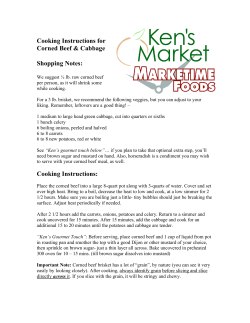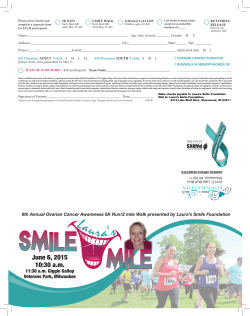
HOW TO TALK TO CONSUMERS Ashley Hughes Florida Beef Council
HOW TO TALK TO CONSUMERS Ashley Hughes Director of Beef Marketing and Promotion Florida Beef Council SMILE. A warm, inviting smile makes people want to be around you and find out what you are doing. If you catch someone's eye, be sure to give a little smile, and be sure to smile often when you talk- it lets people know you appreciate talking to them. o Smile with your eyes. When you do make eye contact, don't stare or glare. Instead, soften your eye expression and make your eyes "smile" or "twinkle" to show that you're friendly and interested in talking to the other person. o Your eyes are not only your window to the world, they're also other people's window into you. If you bury your head in your phone, stare at the floor, or look up at the ceiling, you close that window. Scan your environment with your eyes, and don't be afraid to make eye contact with people. o You want to give direct eye contact, but not too much. Don’t scare them- make them feel comfortable and involved in what you’re doing. o LET GO OF YOUR EGO. Prepare to be ignored. Prepare to be brushed off in a dramatic fashion. When you take the risk of talking to someone you don’t know, rejection is certainly a possibility. Try to see failure as exciting — it’s a chance to learn and improve. o People don’t bite. A lot of people are really open to conversation. In fact, you’d be amazed at how many people will be practically overjoyed that you came and talked to them, as if they’ve been waiting for you to approach them. o Rejection is no big deal. This can't be emphasized enough. Still, fear of rejection will be the main reason why people don’t go out of their bubble and approach strangers. If you are willing to get rejected, brush it off and keep going. You will have an awesome time. o KNOW HOW TO START A CONVERSATION. Don’t count on other people to come to you; be ready and willing to walk up to anyone who looks interesting and forge a connection. o Make sure you know how to use confidence and welcoming body language to disarm anyone who might be on their guard. o FOCUS ON BODY LANGUAGE. We all speak with body language, and you don't have to actually say anything to communicate a message to others. Unfortunately, your body may not always say what you want it to. If you are saying "I'm too busy" or "Leave me alone" with gestures like crossed arms or downward eye contact, it's likely people will not interact. o Hold yourself with a tall, open stance. Smile when you make eye contact with someone. Hold your body in a relaxed and easy and others will flock to you. o Avoid your phone. We all need to send a text once and while, but if you consistently check your phone you will look completely unapproachable. To look inviting, you must be accessible. o Avoid touching your hand to your face, especially putting it over your mouth. Also avoid other nervous habits — picking at your cuticles or biting your fingernails for instance — can also make you appear distant or lost in thought. o o And these are DEFINITELY not okay when you’re preparing food or passing out samples. CREATE MESSAGE POINTS. o What is the story you want to tell? o Tell your story and highlight what you know o o o Make it easy for you to “tell your story” o Make it easy for others to understand and remember Use figures, facts, examples, quotable language, personal anecdotes, metaphors o o o o “Beef has 10 essential nutrients.” “There are 29 lean cuts of beef with less than 10 grams of fat.” “Beef. One powerful protein.” Who are you saying it to? o Know your audience o o No one knows your story like you do. Ie. supermarket mom, activist college student, curious consumer, etc. Message points give you a “life raft” to cling to if the waters turn rough KEEP IT SIMPLE. The best way to make a connection with someone is to come from the heart. What you say isn’t nearly as important as how you say it. o When in doubt, just say “Hi”. If you’ve never done this before, you may get brushed off several, even dozens of times until you get really comfortable being yourself in front of other people. o o Avoid the use of technical jargon, industry buzzwords and acronyms. o o Brahmers, polled, BQA, NCBA, FCA, GCCW, etc. If you don’t know the answer, don’t speculate. o Use the blocking and bridging technique to relay your message. o o “I may not be the expert on the question you asked, but what I do is _____.” Assume the person you are talking to knows very little about the subject. o Make it simple to understand. TRY OFTEN. If you’re still terrified by the idea of talking to strangers, challenge yourself to talk to one stranger a day, every day, for 30 days. o o If you’re walking past someone on the sidewalk, say “Hi”, and the person looks at you and keeps walking (done that many times), your job is done for the day. The point of this exercise is to get you used to talking to people you don’t know and form the habit of being more social. If people aren't approaching you, why not go to them? Nothing makes you look more approachable than actively seeking out people and talking to them. Be open minded and non-judgmental. o TIPS. When you talk to a person don't tilt your face away from them. It makes things more awkward than if you were looking them in the eye. o Position yourself for conversation. If you're standing up, but everybody else is sitting down (or vice versa) people will find it difficult and somewhat awkward to talk to you. If you want to talk to someone, or if you are interacting with someone, position yourself so you can comfortably speak. o Don't immediately turn away if someone looks at you. Look into their eyes for a brief second then look away. It will make the other person more interested in you. o Aside from body language, other elements of your appearance can affect how approachable you look. Dressing in clothing in light/bright colors will make you stand out more in a crowd and look more approachable. Also, make sure you have your hair pulled back, clean hands and nails and have an overall “pulled together” look. o HOW TO TALK TO CONSUMERS Ashley Hughes Director of Beef Marketing and Promotion Florida Beef Council
© Copyright 2025





















